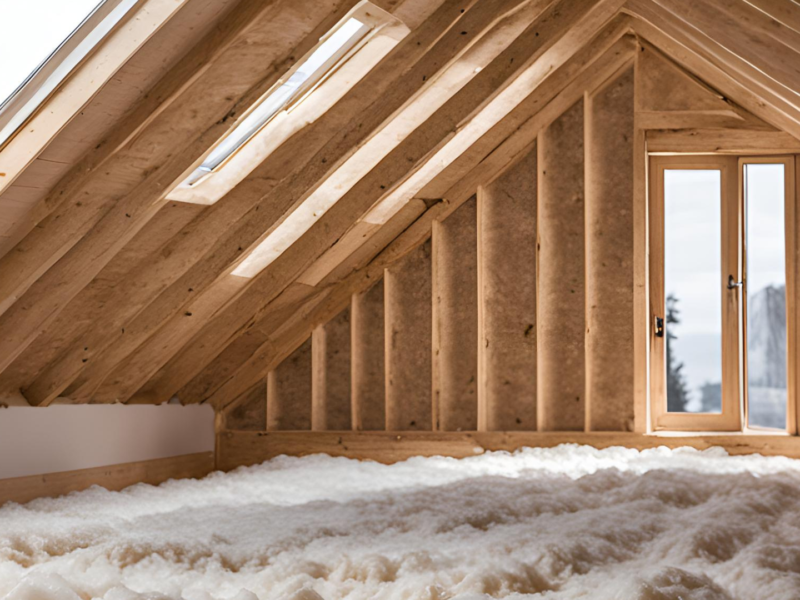FULLY FUNDED
LOFT INSULATION
Improving the quality of your home at no cost
with energy efficient solutions
What is Loft Insulation?
- Types of Insulation: Common materials include fiberglass, mineral wool, cellulose, and foam boards. Each type varies in terms of installation method, R-value (thermal resistance), and cost.
- Benefits:
- Energy Efficiency: Reduces heat loss, which can lower energy bills by up to 25%.
- Comfort: Helps maintain a consistent indoor temperature, improving comfort.
- Environmental Impact: Lowers carbon footprint by reducing the need for heating and cooling energy.
- Installation: Can be a DIY project for simple roll-out insulation, or require professional installation for more complex systems or higher performance materials.
- Cost: Initial costs vary but are generally offset by long-term savings on energy bills.
Loft insulation is a cost-effective way to enhance a home’s energy efficiency and comfort while contributing to environmental sustainability.

Who can get Loft Insulation?
- Under the ECO4 (Energy Company Obligation) scheme in the UK, loft insulation is available to various households to improve energy efficiency and reduce heating costs. The eligibility criteria for ECO4 have been designed to target those who are most in need. Here’s a detailed breakdown of who can get loft insulation under ECO4:
Low-Income Households: Households receiving certain income-related benefits, such as:
- Pension Credit
- Income Support
- Income-Based Jobseeker’s Allowance (JSA)
- Income-Related Employment and Support Allowance (ESA)
- Universal Credit
- Working Tax Credit
- Child Tax Credit
- Housing Benefit
- Pension Guarantee Credit
Private Tenants and Homeowners: - Both private tenants and homeowners can be eligible, but for private renters, landlord permission will be required
- Social housing tenants can also qualify if their property has an Energy Performance Certificate (EPC) rating of E, F, or G.
ECO 4
ECO 4 funding refers to the fourth iteration of the Energy Company Obligation (ECO) scheme in the UK. It’s a government-backed initiative that helps homeowners and tenants improve their homes’ energy efficiency, thereby reducing carbon emissions and fuel poverty.
Key features of ECO 4 funding:
- Active period: April 2022 to March 2026
- Funding amount: £4 billion
- Focus:
- Greater support for vulnerable households: Prioritizes low-income, fuel-poor individuals and families.
- Deeper retrofit for least efficient homes: Aims to upgrade homes in energy efficiency bands E, F, and G to at least band C or D.
- Wider range of measures funded: Includes insulation, heating upgrades, renewable energy technologies, and district heating connections.
- Delivery channels:
- Energy suppliers directly install measures in eligible homes.
- Local authorities can refer households to the scheme.
Benefits of ECO 4 funding:
- Lower energy bills: Improved energy efficiency means reduced energy consumption and lower costs.
- Reduced carbon footprint: More energy-efficient homes contribute to combating climate change.
- Warmer and more comfortable homes: Better insulation and heating systems create a more pleasant living environment.
Eligibility for ECO 4 funding:
- Homeowners or tenants in England, Wales, and Scotland can apply.
- Specific eligibility criteria depend on factors like:
- Property type (house, flat, etc.)
- Household income
- Receipt of certain benefits
- Energy efficiency rating of your home
How to apply for ECO 4 funding:
- Contact your energy supplier: They will assess your eligibility and available measures.
- Arrange a home survey: An assessor will visit your home to determine the most suitable upgrades.
- Receive funding confirmation: If approved, your supplier will coordinate installation of the measures.
Important resources:
- ECO4 website: https://www.gov.uk/government/consultations/design-of-the-energy-company-obligation-eco4-2022-2026
- Ofgem’s ECO4 FAQs: https://freeinsulationscheme.org.uk/eco-plus-scheme/
- Simple Energy Advice: https://www.digitalmarketplace.service.gov.uk/digital-outcomes-and-specialists/opportunities/16873
- Energy Saving Trust: https://energysavingtrust.org.uk/

How does Loft Insulation work?
Loft insulation works by reducing heat loss through the roof, acting as a barrier to heat flow.
It uses materials with low thermal conductivity, such as fiberglass or mineral wool, to slow down heat transfer via conduction and reduce air movement via convection.
This helps retain warmth inside during winter and keeps heat out during summer, enhancing energy efficiency and reducing heating and cooling costs. Various types of insulation, like blanket, loose-fill, sheet, or spray foam, are used to achieve this, each suited to different installation needs and providing benefits like cost savings, improved comfort, and lower environmental impact.
Previous work







